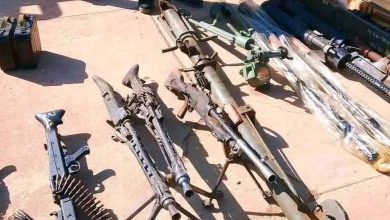The Collapse of the Mercenaries in Khartoum… Paralysis Strikes the Militia’s Body

Sudan Events – Agencies
The Rapid Support Forces militia failed to withstand the storm of the Sudanese army since its historic crossing of the bridges on September 26. Since then, the army’s strategy of “digging with a needle” has proven highly effective. The army controlled Mount Moya, Dinder, Suki, and all the northern villages of the Sennar state, then Sennar city, the Sennar Sugar Factory, and areas south of Al-Jazeera, reaching the capital of Wad Madani.
The Collapse of the Militia in Khartoum:
In the capital Khartoum, it became clear that the militia, which had been fiercely fighting in areas like Bahri and the Merkan in central Khartoum, was on the verge of collapse at any moment under the army’s strikes. The army benefited from the war period to develop its soldiers’ capabilities and improve its weaponry, with unprecedented popular support.
According to experts, as reported by “Sudanese Echoes,” the achievements made by the army in Khartoum, culminating in the liberation of the Jeli Refinery and breaking the siege of the General Command, could have been achieved in the first month after crossing the bridges, but with greater losses. They pointed out that the “digging with a needle” policy, which was announced by the Commander-in-Chief of the Armed Forces, General Abdel Fattah al-Burhan, and mocked by some, was the decisive factor in achieving these victories with fewer losses. This policy proved to be highly successful and contributed to gradually weakening the militia’s body, until it reached a stage where further attempts to repair it or continue fighting with half-destroyed forces were futile.
Ultimately, this policy led to the collapse of the militia in Khartoum, with the army reaching the walls of the General Command after 22 months of siege. Experts view this clash as an indicator of the full and accelerating liberation of Khartoum, similar to the process of descending from a high place.
Expressive Images:
The “digging with a needle” policy was clearly reflected in Khartoum state during scenes seen on Friday, when the first elements of the moving army reached the Signal Corps at Shambat. The militia forces fled from Tuti Island, evacuated the police station and hospital in Buri, as well as Khartoum Airport and the criminal evidence building. Areas like Arkweet, Al-Mamoura, and Sixty Street in eastern Khartoum saw militia fighters fleeing towards East Nile and southern Khartoum. The air force dealt with the militia convoys fleeing west of Jebel Awlia Dam on Saturday morning, killing about 600 rebels. This rapid collapse couldn’t be contained by the false statements from the militia leader’s advisors, which aimed to keep the rebels united. Initially, they denied the clash between the armies, then claimed a small force had infiltrated the General Command and taken photos. However, at the same time they were making these lies, an Al Arabiya reporter was live from in front of the General Command, while Burhan was privately celebrating at the Jeli Refinery.
The End of the Khartoum War:
Observers are certain that the Khartoum battle ended the moment the armies clashed, noting that the army will open from the General Command to the east and south, while other forces will open westward to control the Mak Nimir Bridge, the Republican Palace, and the Souq Arabi area, meeting the Engineer Corps soldiers in the Merkan area. Forces will then advance south to control strategic sites such as the currency mint and meet with the armored forces. The 18th Division from Kosti will move to clean the area of Al-Qatina and control Jebel Awlia. The Shendi Army, the Sudan Shield, and the First Division from Madani will move to East Nile in a major operation to control East Nile, while the Sennar Army will advance to control areas north of Al-Jazeera, including Alti, Al-Masoudiya, and the areas of Soba south of Khartoum, where they will meet the armored forces at the Central Square. It is expected that these battles will not last more than two months, with rapid collapses within the militia.
Source: “Sudanese Echoes”



